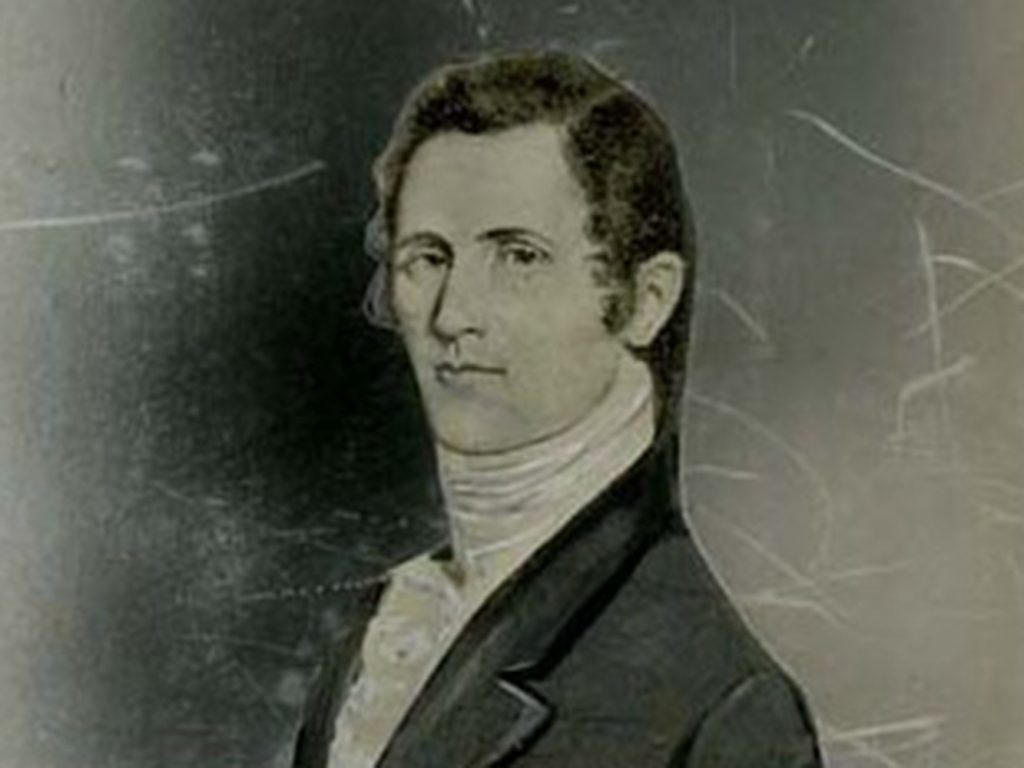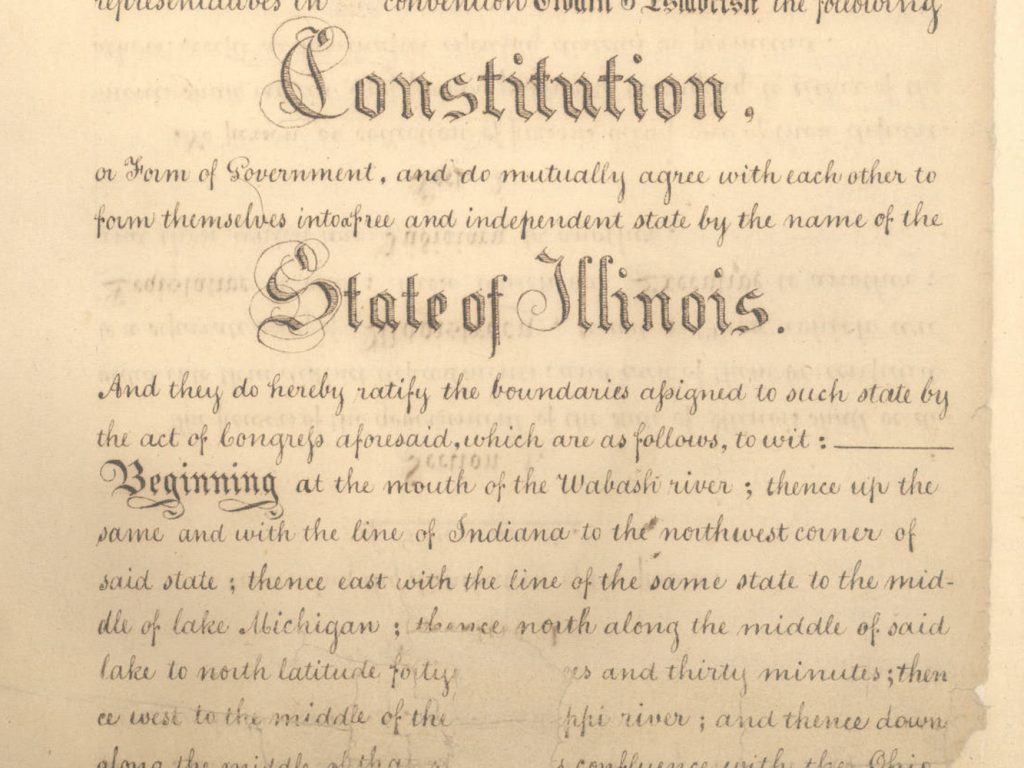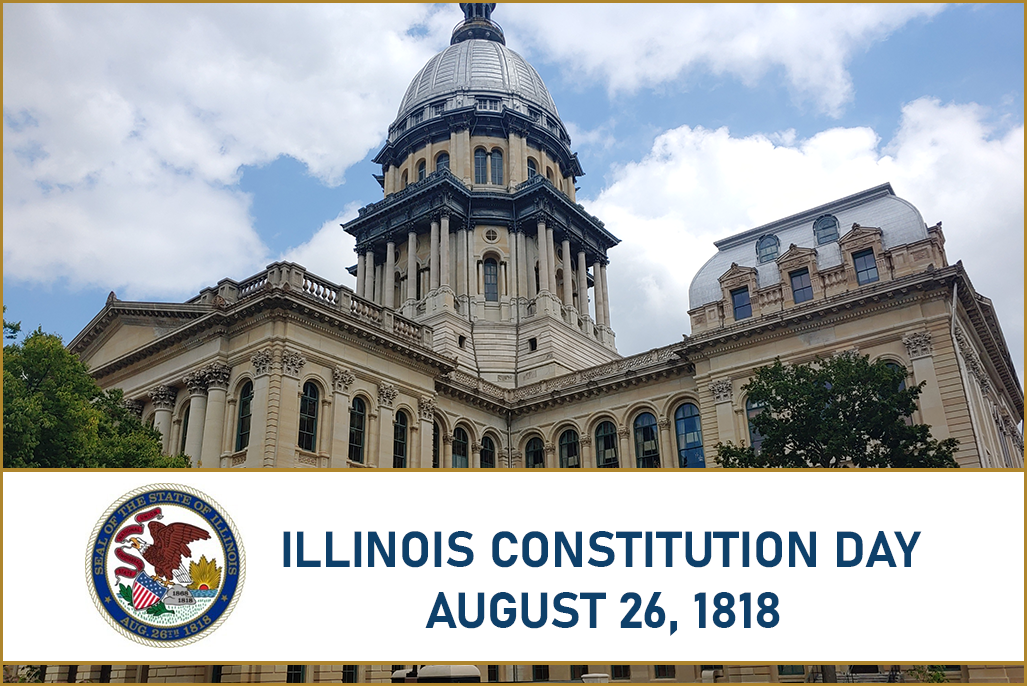The Illinois Constitution
Illinois Constitution Day is observed every August 26. This date marks the ratification of Illinois’ first state constitution in 1818, a milestone moment in Illinois’ journey to statehood. This day now offers an opportunity to reflect on the significance of this historic event and how it continues to shape the governance and identity of Illinois. House Bill 2834 from the 102nd General Assembly, which establishes Illinois Constitution Day, was introduced in 2021 to ensure that the significance of the state’s constitutional history is recognized and celebrated statewide.
The ratification of Illinois’ first constitution on August 26, 1818, was a defining moment. The new constitution established the legal framework necessary for Illinois to transition from a frontier territory to a full-fledged state within the Union. At the time, Illinois was a sparsely populated territory, home to a mix of Native American tribes, European settlers, and African American communities—both free and enslaved.

This first Constitution was largely drafted by Elias Kent Kane, a Yale graduate and a lawyer from New York. Kane’s legal background and the influence of other state constitutions—particularly those of New York, Ohio, and Kentucky—played a significant role in shaping Illinois’ founding document. The Constitutional Convention, held at Bennett’s Tavern in the territorial capital of Kaskaskia, saw 33 delegates from 15 counties convene to draft this crucial document, with Judge Jesse Thomas serving as presiding officer. Remarkably, the delegates managed to draft, debate, and approve the Constitution within just three weeks. It was not submitted to the people for approval, but its adoption was celebrated with speeches in the capital city and the firing of 20 cannon rounds.
The 1818 Constitution begins with a declaration by the people of Illinois that, “in order to establish justice, promote the welfare and secure the blessings of liberty to themselves and their posterity, do by their representatives in convention, ordain and establish the following Constitution form of government; and do mutually agree with each other to form themselves into a free and independent State by the name of the State of ILLINOIS.”
This document provided for a relatively simple governmental structure with a bicameral legislature, a governor, and a judiciary. Article I set forth the division of powers which has become standard in the U.S.: three branches with distinct powers, and a prohibition on any branch exercising the powers reserved to another. Article II established the House of Representatives and Senate “both to be elected by the people,” a divergence from the federal Senate, which for another century would have its members appointed by state legislators.
The minimum age to be a state representative was set at 21, and the person was also required to be a U.S. citizen and an inhabitant of Illinois, though the framers did have to make some accommodation for local residency in counties which were in those days still being established. Unlike today, Senators had to be at least 25. The Senate was divided into two classes, with Senators serving staggered four-year terms, so that one half or the other would face the voters in each general election.
“The number of representatives shall not be less than twenty-seven, nor more than thirty-six,” and “the number of Senators shall never be less than one-third nor more than one-half of the number of Representatives,” reads a portion of Section 5. The Constitution’s framers wrote that these figures would change when the state reached 100,000 in population (from just under 40,000 at statehood), but they did not specify how.
The House would elect a Speaker, two-thirds of members had to be present to constitute a quorum, and each chamber would set its own rules. But when a vacancy occurred, the first Constitution directed the Governor to “issue writs of election to fill such vacancies.” Members were also protected from arrest during session and while traveling to and from the capital, except in cases of “treason, felony, or breach of the peace.” This immunity continues today.
Today’s requirement that bills be read on three separate days in each house is included in the first Constitution, but with the caveat that, “unless in case of urgency, three-fourths of the House where such bill is so depending deem it expedient to dispense with this rule.”
The first Constitution also set the salary of the Governor at $1000 and the Secretary of State at $600.
Article III set up a very weak Governor. Having had a string of bad experiences with executives in the years before statehood, the framers sought to put limits on executive authority in the new state. The Governor would hold a four-year term, but could not seek re-election. “He shall be at least thirty years of age, and have been a citizen of the United States thirty years; two years of which next preceding his election he shall have resided within the limits of this State.”
The Governor was required to give a report to the General Assembly on “the state of the government,” and could suggest such legislation “as he shall deem expedient.” The Governor could issue pardons, call special sessions of the legislature, and was also the head of the state militia.
But a major difference between today’s Constitution and that of 1818 concerned the Governor’s influence on legislation. The Governor could not unilaterally veto legislation. Instead, bills passed by both houses could only be vetoed by a “council of revision,” made up of the Governor and the four Justices of the Illinois Supreme Court. Even if the Governor succeeded in getting consent to veto a bill, it could be overridden by a majority of each house.

The 1818 Constitution also allowed the legislature to appoint most of the statewide officials. Only the Governor and Lieutenant Governor were popularly elected. The Governor could appoint the Secretary of State, but the legislature would choose a state Auditor, Attorney General and “such other officers of the state as may be necessary,” a term which was not defined. Legislators and the incoming Governor disagreed over who would be appointed state Auditor, so legislators made sure to keep that power for themselves. That decision planted the seeds of much controversy over the first 30 years of statehood.
One of the last chief executives to serve under the first Constitution, Governor Thomas Ford, wrote that this system of appointments, “led to innumerable intrigues and corruptions, and for a long time destroyed the harmony between the executive and legislative departments.”
The Constitution established the other statewide offices: Lieutenant Governor (who was also “Speaker of the Senate”), Secretary of State, Treasurer and Public Printer.
Article IV vested the judicial power of the state in the Supreme Court, and any “inferior courts” which the General Assembly chose to create. The Supreme Court was made up of four justices, including a Chief Justice, but the Constitution left open the possibility of increasing its membership after 1824. Justices were “appointed by joint ballot of both branches of the General Assembly and commissioned by the Governor.” They would meet in the capital city, but would also travel a circuit hearing cases when the Supreme Court was not in session. This copied the practice at the time for Justices of the U.S. Supreme Court.
The 1818 document also reflects some of the disappointing history of our state and our country. Legislative seats were apportioned among the districts, “according to the number of white inhabitants.” Voting was restricted to “white male inhabitants above the age of twenty-one years,” and an “enumeration of all the white inhabitants of the State shall be made in such manner as shall be directed by law,” every five years. Article V established a racially-segregated state militia.
Article VI begins with a bold statement about slavery, “Neither slavery nor involuntary servitude shall hereafter be introduced into this State,” but then proceeds to outline exceptions. Some of these exceptions permitted existing slavery within the state’s boundaries “within the tract reserved for the salt works near Shawneetown,” but only for a single year, with a total ban to take effect in 1825.
In reflecting on this Constitution, it’s essential to recognize the significant challenges and triumphs that it represents. The delegates who gathered in Kaskaskia faced the immense task of creating a governing document that would not only establish order and promote the welfare of Illinois’ residents but also navigate the complex and often contentious issues of the day. Slavery, voting rights, and the balance of power between the state and its people were all hotly debated topics that required careful compromise and, at times, difficult decisions.
The ratification of the 1818 Constitution marked the beginning of Illinois’ journey as a state, but it was only the first step in a long process of growth and evolution. As Illinois grew in population and complexity, it became clear that new frameworks of governance were needed to address the changing needs of its citizens. This led to the adoption of three subsequent constitutions in 1848, 1870, and 1970, each building on the foundations laid by the 1818 document.
The 1848 Constitution was adopted during a period of rapid population growth and economic expansion in Illinois. This second constitution expanded voting rights and reformed the state’s judiciary, laying the groundwork for a more participatory democracy. However, as the state continued to grow, it became evident that further reforms were necessary to address the emerging challenges of a more industrialized and interconnected society.
The 1870 Constitution, which remained in effect for nearly a century, introduced significant changes to Illinois’ government, including stronger protections for individual rights, the establishment of a state board of education, and the creation of a more complex system of taxation. This constitution also included provisions to limit the power of corporations, reflecting the growing influence of industrial interests in the state.
The most recent constitution, adopted in 1970, is particularly noteworthy for its modernization of state government and expansion of individual rights. It introduced the concept of home rule, giving local governments greater autonomy, and strengthened the Illinois Bill of Rights, ensuring broad protections for citizens. This constitution remains in effect today and continues to guide the governance of Illinois.
Illinois Constitution Day is a celebration of the state’s commitment to democracy, governance, and the rule of law. By designating this day, the state acknowledges the importance of the constitution as a living document that continues to influence Illinois’ government and society. It serves as a reminder of the state’s rich history and the ongoing relevance of the principles laid out in its foundational document.
As we commemorate Illinois Constitution Day, we are reminded of both the progress we’ve made and the work that remains. It encourages all Illinoisans to take an active role in the democratic process, to understand their rights and responsibilities under the constitution, and to work together to build a better, more just, and more equitable state for all.
